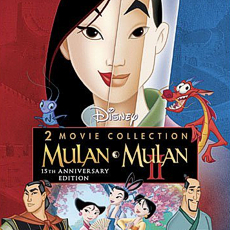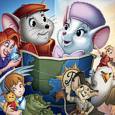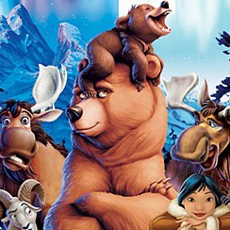Walt Disney Feature Animation, DisneyToon Studios (June 19 1998, November 15 2004), Walt Disney Home Entertainment (March 12 2013), Blu-ray plus two DVD discs, 88 and 79 mins plus supplements, 1080p high-definition 1.66:1 and 1.78:1 widescreen, DTS-HD Master Audio 5.1, Rated G, Retail: $39.99
Storyboard:
Based on old Chinese folklore, Mulan follows a young headstrong Chinese girl who rebels against her pre-arranged marrying off and swaps her dresses for a soldier’s uniform to take her ailing father’s place in the battle against the Huns. Along the way, she falls for, and gets into a complicated relationship with, her captain, Shang, and is aided and abetted by her ancestral protector, the diminutive dragon Mushu, and a “lucky” bug, a cricket named Cri-Kee. Proving that behind every great man is a greater woman, Mulan is able to use her smarts to help Shang and his rag-tag band outwit the Huns, until an unexpected situation threatens to reveal her secret and expose her true identity…
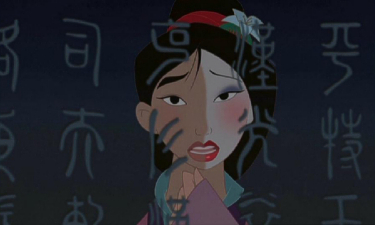
The Sweatbox Review:
Arriving amongst another slew of same-day Blu-ray updates for other Disney titles from roughly around the same period, the Studio’s telling of the ancient Chinese legend of Fa Mulan easily holds up as one of their more “classic” animated features from its late-1990s offerings. First mentioned as ripe for story treatment as far back as when then-Studio head Jeffrey Katzenberg was trying to up the ante on animated films and build on the critical and commercial success of Beauty And The Beast, Mulan was initially plotted as a deep drama, in the vein of Pocahontas and The Hunchback Of Notre Dame. However, and as went on to happen to so many of the Studio’s more dramatic pictures from this time, once Katzenberg left the Studio in late 1994, the story was infused with a little lighter touch and handed over to the then-still fairly green Florida feature unit, who up until that point had mainly been responsible for Disney’s Roger Rabbit shorts, and small (mostly more “cartoony”) sections of the Burbank animated features.
The big question was: could they not only handle such an undertaking, but also one that needed careful treatment and a fine juxtaposition between the overly “toony” feel and true emotional storytelling? The answer, for those that have previously enjoyed Mulan’s many delights, is a resounding “yes” of course, even if some of the animation can sometimes be somewhat unsophisticated in nature. The artists at the then flourishing Florida unit were largely still learning the ropes, although the creativity and achievements on show certainly indicated what was to come with their follow ups Lilo And Stitch and Brother Bear, itself one of the other titles making its BD debut on the same date. Mulan doesn’t quite feel like classic, epic Disney, but it’s not far off, and very much a film from the same stable, still leagues ahead of what other Studios were putting out at the time, and still more charming than the majority of CGI “comedies” pumped out today.
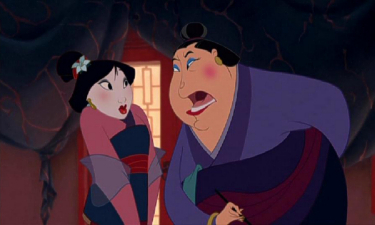
As a piece of storytelling, Mulan is as solid as Disney comes. The script is paced well, with neither the humor nor the drama ever overpowering the other. Directors Tony Bancroft and Barry Cook pack their film with several set pieces, as well as some nicely staged minor moments, which do manage to balance out the film. The use of CGI, still fairly new at the time of production, is done sparingly, though it is sometimes easily possible to pick out those scenes that employ the technique. Most glaringly obvious is the Hun army’s stampede, a sequence inspired by, and that heavily recalls, the not so dissimilar moments in The Lion King with the wildebeests. Still, it’s an exhilarating moment, even if it never quite really reaches the highpoint that it might have done. Mulan is also a pioneering movie in other ways too: providing his first comic relief role in an animated film and essentially setting up the tone for his later performances in the Shrek films is Eddie Murphy, who here is bags of fun, and not nearly half as annoying as Donkey could become at times.
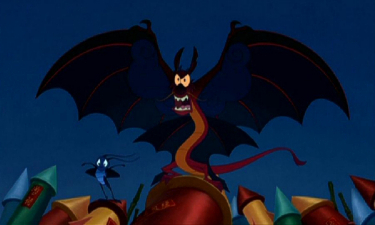
His tiny ancestral protector dragon Mushu almost walks off with the movie, taking the dual roles of a semi-narrator and guide to Mulan. He not only keeps tabs on the story but also becomes involved when he needs to be, coming up with just the right laugh line to say at critical emotional points – truly a classic Disney sidekick character that really works. For older fans, his line to the guards as he “drops in” during the final fireworks sequence is a very funny throwback to one of his earliest roles! As a fellow comedy relief, Cri-Kee is given much less to do, and almost comes off as an afterthought (indeed, he seemingly disappears for sequences at a time, only to appear again when really needed). I’m not quite sure what role he was intended to play, but sometimes Cri-Kee only works when he’s playing off from Mushu himself eventually becoming something of a sidekick’s sidekick! On the visual side, the animation is fine, and Mulan’s quick-changes from girl to boy are always handled well, the switch never at all the hot potato that it could have been.
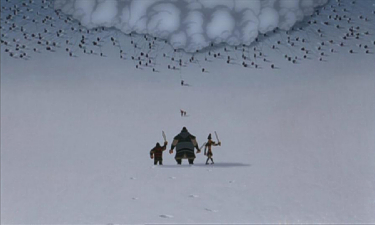
Interestingly, the use of montage in animated films has always been so-so in the end results, but Mulan’s initial gender-bending and the later recruitments’ training scenes are expertly realised. Helping things along is the score, by the legendary movie composer Jerry Goldsmith, and Matthew Wilder’s songs. Goldsmith imbues the film with a couple of highly majestic themes, as was his stock in trade toward the end of his career, but unlike the majority of his Star Trek work, the music here always feels fresh and suits the mood perfectly. Though not technically a musical (actually like many of Disney’s films if one looks closely at the song-to-story ratio), Mulan does contain four such moments, which strive to push emotion or story forward, to varying degrees of success. Providing Christina Aguilera with an early hit was the pop single version of Mulan’s “I want” song, Reflection, which is right up there with Part Of Your World when it comes to the lonesome musical pinings of Disney’s animated heroines.

A fascinating note is that Stephen Schwartz was at one point to be Wilder’s lyricist, only to be replaced by Hercules’ David Zippel at the last moment. There’s no doubting that Schwartz’ (coming off Pocahontas and before going solo on The Prince Of Egypt) take would have been more sombre (perhaps in keeping with the original treatment of the story), though Zippel does display his knack for some fun wordplay, especially in the warriors’ paean to home, A Girl Worth Fighting For. Of the other songs, Honor To Us All and I’ll Make A Man Out Of You aren’t classics in the Disney canon, but do feel part of the whole overall, helping their respective scenes lift to the emotional wallop they need at their times. Indeed, Honor does a great job of introducing music into the film and both creates the landscape in which this adventure will take place as well as call back to the more traditional Hollywood-stage set musicals of old, a connection further cemented by the performance of Marni Nixon as Mulan’s Grandmother’s singing voice.
As one of the later 1990s animated features to come from the Disney Studio, Mulan has much more to merit it than some of the other efforts to have emerged after the commercial and critical success of Beauty And The Beast and The Lion King changed the feature animation business earlier that decade. In fact, I believe the film just gets better with age: watching it again for this review I was surprised by many little touches I had missed or forgotten about, and the film deftly keeps its various, often complicated, components juggling in the air without dropping any of them to its detriment. Uniquely taking on folklore from a different culture to the usual fairytale sources, Mulan manages to retain its own identity while also slipping into the Disney canon as a pretty great movie and one of the Studio’s most well received films.
Is This Thing Loaded?
Presented as a 2-Movie Collection, this set’s chief addition is the inclusion of the direct-to-video sequel Mulan II, or Mulan-with-a-number-2 as it was when the movie was given limited theatrical release internationally. In America, the movie was overlooked theatrically in order to book another Winnie The Pooh film onto big screens in Disney’s once-annual mid-February slot, an oversight when Mulan II could have been a better bet with some of that famous Disney tweaking. Though not much can touch the power of a Pooh, those movies began to resemble more and more a string of TV-grade episodes strung together to form feature-length outings, but Mulan II has more than that – good quality cartooning of the mid-level type, which does a decent enough job of aping, if not reaching, the original film’s standard, and a running time which surpasses the usual 66-minute length that places such endeavours firmly in the destined-for-TV movie category.

With that longer run time, the story and characters get a better shot at development, though certainly bowing to the sequel law of diminishing returns. Mulan II actually manages to be good fun, while not stepping on the more epic toes of the original, and does that rare thing – as with the concurrently released Brother Bear 2-Movie Collection – in providing a continuation to a Disney movie as opposed to filling in a primary character’s earlier life. Originally the middle part of a never-to-be trilogy, this second instalment picks up as Mulan and her now fiancé Shang prepare for marriage. Handily enough for story purposes, a loophole sees them both recalled to the Chinese Army, where the Emperor declares them the only ones he can trust to escort three princesses across the country to the opposing Mongol borders, where they will marry and create a union between the two sides.
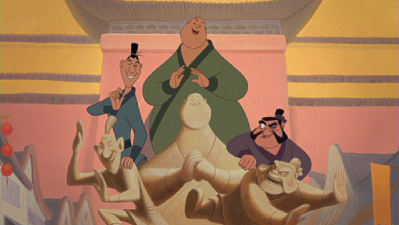
This is not-so-good news for Mushu, who has found his position will be relinquished when Mulan herself marries Shang, and so vows to break them up, while also joining them on their mission are Yao, Ling and Chien-Po, who provide their own brand of “security”. Along the way, Mulan’s feelings that the arranged marriage goes against the wishes of the Princesses’ true hearts are confirmed when they begin to fall for their three guards, but destiny can not be simply wished away and, when the group’s passing through an enemy mountain route seemingly leads to tragedy, Mulan must take it upon herself to complete the mission. If this all sounds a little like a retread of the first film then this is part of the reason as to why Mulan II feels like it doesn’t particularly build on what came before, the occasional moments of déjà vu and the very nature of the DTV sequels tending to stay within the “safe” confines already established by the earlier effort.
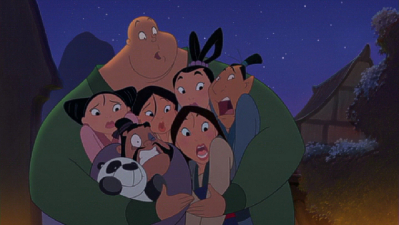
There are various flashes of originality (the I Wanna Be Like Other Girls number is a high-point) which do lend the film its own sense of being, but it is interesting when the first really good bit of a sequel is a reprise of one of the songs from the original! Added to the pros is a returning voice cast, joined this time by Lucy Lui, among others, as one of the Princesses, and Eddie Murphy stand-in Mark Moseley doing a game job of impersonating Mulan’s ancestral guardian. His comic timing is not quite as spot on as Murphy’s, naturally, and though he just about pulls it off, the absence of Murphy is what belies the true difference between a title destined for home video and full theatrical status. The voice differences shouldn’t affect the perception of the film, however, and Moseley’s performance here is more than suitable, just as composer Joel McNeely picks up the baton for Jerry Goldsmith in the music stakes.

As with the film itself, McNeely’s music doesn’t quite reach the heights of Goldsmith’s Oscar-nominated, epic original, but it pushes all the right emotional buttons, especially considering that, due to the nature of such projects, he is unable to use melodies from Goldsmith’s score. He comes very close more than a few times, which helps evoke those original music cues, though that one of the playful love themes sounds very reminiscent of one from West Side Story did keep pulling me out of the lovey-dovey business that was going on on-screen. Integrated well enough into the score are several songs, all of which do their job, even if they don’t tread any new ground. If there is anything “wrong” with Mulan II, it’s that the whole endeavour is overly simplistic, especially in following such an epic and fairly multi-layered first film. Everything from backgrounds to crowd scenes and especially the script, does feel extremely lightweight, and the lack of a villain (or any opposing forces for that matter) really doesn’t help build a substantial story.
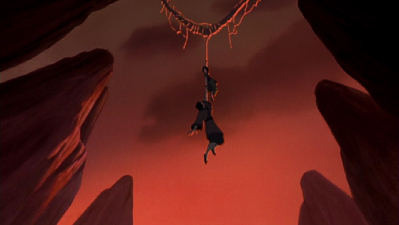
Cost cutting techniques, particularly animation cycles and “crowd control” (why have hundreds when you can get away with a handful?) are all too apparent, and even the mountain fight comes and goes all too quickly. The off-again/on-again status of Mulan and Shang’s relationship gets pretty irritating as well, and is indicative of the frustrating nature of the movie itself. Director Darrell Rooney is usually one to make more of what he’s been given to play with, but here I think the unsophisticated, stretched out story line gets the better of him and, stumbling under the lack of a big budget, he seems to have trouble finding anywhere to insert a set piece or major action sequence. I appreciate that it has been included here so as to not warrant a separate release, but Mulan II doesn’t manage to really progress things further along from the first film, easily making it feel more like a bonus feature rather than a movie that can stand alongside the original. Somewhere beneath the surface, however, there’s a bigger, better film itching to get out!
Moving on from Mulan II, it’s pleasing to report that Disney seems to have finally abandoned the dreaded virtual vault concept adopted for some other titles, the Studio managing to pack both films onto Blu-ray and still retain the majority of the supplements from their previous DVD editions. Mulan’s extensive list of bonus features initially recalls the exceptional LaserDisc box sets of the 1990s, when all matter of things specifically compiled for the collector were included in suitably luxury packages. I’m convinced the material gathered for the film’s two-disc DVD was a remnant of that assembled for an LD box that never happened: apart from being one of Disney’s first DVD releases, Mulan was also one of the last of the Studio’s films to see an LD issue. Heading the list is a full-length producer and directors Audio Commentary. Producer Pam Coats is placed in the middle of the soundstage, with her two directors placed left and right, which opens up the audio spacing of what can sometimes be crowded affairs and sounds much more pleasing.

Not that their comments are in danger of becoming crowded! The trio speak rather dryly and sparingly, not really revealing too many secrets, but opening up just enough to keep it interesting (it’s certainly clear, on hearing about the genesis for Little Brother, that Chris Sanders is definitely a “dog person”). It’s more a discussion about each scene as it unfolds, being more “who worked on what” than an overall dissection of the production, but the basics of Disney storytelling are touched on, as well as the inclusion of songs and music, with the occasional laugh or in-joke pointed out. The crew also turn up to intro a collection of Deleted Scenes, in which we get a glimpse at the in-depth look at production that’s in store during these supplements. Lasting a total of almost 23 minutes, this is still perhaps the most extensive grouping of cut material I’ve yet come across for a Disney film, these early concepts featuring several alternative openings to the film, plus an entire demo song, Keep ’Em Guessing, which would have introduced Mushu in a very different way and given him his own theme tune!
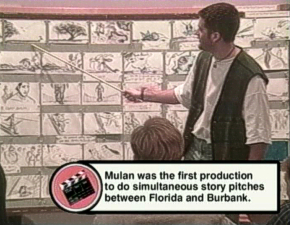
It sounds fun but unfortunately the song is rather uninspired, falling into the danger of being a Friend Like Me knock off, with its big band jazz being very out of place in the final film. More fun is an original shadow puppet opening that sets up not only the story but also the China of the time, featuring some gorgeous test animation. Other sequences that ended up on the cutting room floor include some interesting variations on the main villain character, and yet another opening that begins with a hugely majestic choral arrangement that could have been too literal and overbearing for its own good. Staying backstage, and Mulan’s Fun Facts is a Mushu-sized look at the production. Those hoping for pop-up trivia throughout the film may be disappointed – this is a brief video clip (from badly dubbed VHS by the looks of things) which features only a few snippets of info, but it’s quickly cut and a fun addition that sneaks in some irreverent stuff as well (such as “if the 27.780 pencils used to draw Mulan were laid end to end…the movie would have never been completed”)!
Remaining in Classic Backstage Disney also offers a collection of six headings that cover everything from the original poem that inspired the legend of Mulan to the eventual film’s international releases. While there isn’t a Play All option that runs these pieces as one documentary, the Blu-ray also loses the ability to view the clips in one sitting within a given topic…no real biggie but less fluid nonetheless. The Journey Begins starts us off: here, Discovering Mulan is an introduction of the Disney artists to the tale and their research, and The Ballad Of Hua Mulan showcases the original poem that inspired the legend, told through narration, concept images and expertly edited music from the great Goldsmith score – an artfully composed piece that almost works as a short film in its own right. With two Early Presentation Reels (from 1995 and 1996 respectively) adding up to around 17 minutes of material, the pieces here do not seem rushed or full of fluff, though they are edited in typically slick fashion, complete with producer Coats talking about the artists’ research trip to China and showing plentiful amounts of VHS footage, photo stills and further early concept sketches.
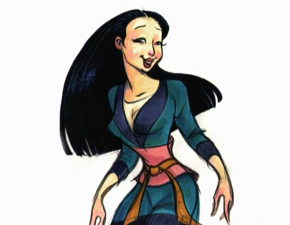
The two presentation reels could have benefited from an intro or two to place them in context, which would have helped those not familiar with the production’s history. The first seems to be not much more than the “transformation” scene told in storyboard form, while the second is longer, and more what one might be used to with such things: a “tone guide” with temp music, which outlines the film’s concepts in visual form. This looks like it could have been from back when the production was going for all out dramatic emphasis, with heavily saturated colors and strongly stylised ideas – an interesting look at the developmental process. In The Artists’ Journey, we find several more clips looking at the animated filmmaking process. Firstly, Finding Mulan is a lengthy seven-minute piece on how the artists approached the character, both in personality and visual style, with the participants talking about how the story changed from being more of the usual Disney “protagonist wants to escape their humdrum life” take to becoming the “girl with a mission” story that Mulan would finally appear as.
A Storyboard To Film Comparison of an early Mushu scene is next, presented as a good old fashioned recurring sequence of the same scene played through various stages of production: from storyboards by Chris Sanders, as the finally rendered film, or as a split-screen playing out the minute-twenty clip with both options on one screen, which is the best way to compare the scene instantly. In Design, three featurettes outline the tone and style directions the film variously went off in, as well as obviously where things ended up, amounting to 14 minutes of material. The first of these, Art Design, speaks in depth on much of the concept art we have already seen, and places these pieces of art into context. Character Design builds on the artists’ philosophy on the artwork in the film, and how the characters were designed to be placed within their respective backgrounds without any clashing of styles. Ballad Of Color looks at the way the artists used color to help pack the emotional punch of certain scenes, as well as how they adapted cultural Chinese colors for costume choices and scene moods.

Moving on to Production, and two headings offer a couple of progression demonstration options: Mushu Awakens and Matchmaker Meets Mulan, both shown in various stages of development. A little like the Storyboard Comparison, these scenes build on that by going through the various stages in-between, from sketches and rough animation, to clean-up, effects and final color, presented as before in individually shown sequence, since the Blu-ray does away with the DVD’s angle toggling functionality. Digital Production is made up of two featurettes, The Hun Charge and Digital Dim Sum, that take in the use of CGI in the film, from the evil Hun army’s set-piece attack to the quick way the technicians found to replicate large numbers of crowds for Mulan’s final sequences, and a new adaptation of the Multiplane Camera (pre-Deep Canvas). All in all, this very interesting Production section adds around a further 17 minutes to the bonus section.
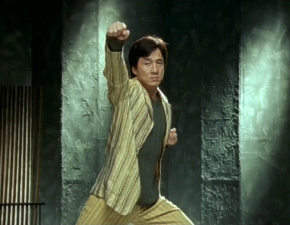
The Classic Music & More section jumps right into the same collection of music videos for songs from the film as seen on the previous SE DVD, kicking off with the Mandarin Chinese version of I’ll Make A Man Out Of You, sung by Jackie Chan for release in that country in what is basically a sung to camera shoot with his version of the track in the original film arrangement (Chan also supplied the dubbed voice in China). About the only thing, apart from a theatrical teaser, included on the original Gold DVD release were the videos for the film’s two pop single releases, and it’s nice to see those carried over again here: Christina Aguilera’s Reflection and 98 Degrees/Steve Wonder’s True To Your Heart (both from the Gold release). There’s also a Spanish version of Mulan’s theme, Reflection, from Mexican actress Lucero, which truly shows how “cut and paste” some of these clips can be: it’s a virtually shot-for-shot identical version of the Aguilera video, and I wouldn’t be surprised if they’d filmed both at the same time, setting up the shot and having the two singers perform their parts before moving on to the next set up.
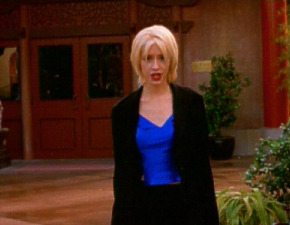
True To Your Heart is also over-emoted by Disney Channel star Raven in a “new” version, although this is little more than just her in the recording studio and a promotion for the DisneyMania 2 compilation (as the always-onscreen wording keeps reminding). Still, at least these are all full-length videos and not the 30-second spots we used to get on Disney’s DVDs, running well over three minutes a piece. Another clip, Songs Of Mulan, outlines how the songs were spotted in the film and the emotional tone each should have. While Mulan isn’t a full-on musical per se, these moments are an integral part of the overall package, and the just-over-five minutes awarded to the subject here don’t really do the process justice. Also, especially given his death soon after the film’s release, it’s a glaringly missed opportunity not to touch on Jerry Goldsmith’s score – he isn’t even mentioned here, despite being a grand old master of film music and having this particular score Oscar nominated in 1998. Very much an outstanding omission, it’s a shame this update didn’t find room to fix this; instead it remains the set’s major dent in receiving a top supplement score.
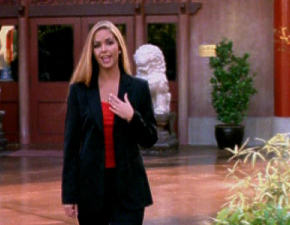
Mulan’s International Journey looks at the usually underrated folks at Disney Characters International and the job they do translating each and every animated movie into foreign languages. The care put into these translations is readily apparent, and speaks volumes for the always big box office that Disney pictures do internationally. The task of bringing Mulan back to Chinese audiences is brought up, with the casting of Jackie Chan in Captain Shang’s role seen as a most important part of the film’s success there. We also see brief moments from the Mandarin version of the Reflection video, surely a more interesting addition than the Spanish clip included? I’ll Make A Man Out Of You is reprised in a Multi-Language Version, something I always find a fun feature when Disney includes them. Cycling through the various languages that the film was released in, it’s further credit to the Disney Character people that it still works and that the voices match up as well as they do, both to original intention and in lip-sync (both these international-focused featurettes add up to nine more minutes of material).

The not-surprisingly more barren DTV disc for Mulan II still contained a trio of extras, which have also been retained here. Voices of Mulan II is a very brief, but very packed, three minute look at the voice cast, glossing over Murphy’s no-show, but featuring soundbites from just about everyone else. The closest anything gets to a behind-the-scenes peek, this one just about cuts the mustard, but is more welcome than nothing. After a fun intro and the pre-requisite “these are just pencil drawings” talk, a bunch of four Deleted Scenes demonstrate yet again that the DTV crowd can be counted on to remove the more ambitious moments of their films before they enter final animation – moments that, as usual, would have made their film instantly more epic! Best of all is a lengthy opening battle sequence that, even in storyboard form, almost puts all of what is in the eventual film to shame! Together, the clips add up to just less than 12 minutes of material.
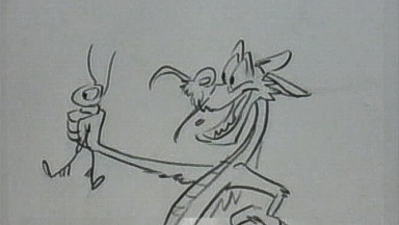
Finally, the two-and-a-half minute I Wanna Be Like Other Girls music video, supposedly featuring “pop sensations” Atomic Kitten, though the trio of babes are nowhere to be seen here, since their end-credit pop version of one of the film’s songs is completely covered up by clips from the film. On the enclosed Mulan and Mulan II DVDs, each film is accompanied by a surprising amount of bonus material. On Mulan the commentary, deleted scenes, music videos, multi-language clip, Finding Mulan and Fun Facts featurettes are all included, while Mulan II retains its deleted scenes, music video and Voices Of Mulan featurette. Across all discs, Sneak Peeks feature for The Little Mermaid’s 3D Diamond Edition, Monsters University, Disney On Ice: 100 Years Of Magic, Newsies on Broadway, the full trailer for the semi-Pixar-less Planes and Return To Never-Land amongst other Disney promo spots.
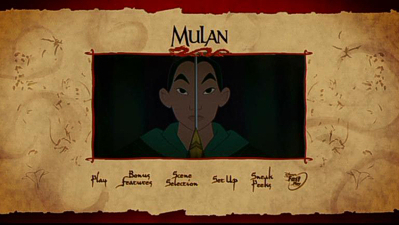
While this is still an extensive menu of extras, there’s are some elements missing from the expected line-up: the original Limited Issue/Gold Collection release featured a pre-release teaser trailer, and the Special Edition additionally included an interesting Mulan’s World educational bonus that explored the various themes and cultural references in the movie, ranging from Mulan herself and her place in Chinese history, to the mythology of dragons and the Great Wall. Moreover, two Art Galleries are a no-show, so some wonderful Publicity images and an extensive collection of developmental images (grouped under such titles as Character Design, Visual Development, Backgrounds And Layouts, Landscapes And Architecture) are not referenced, not even in a video-based art review format, which is a great pity.
Not that it makes a great deal of difference, but Mulan II is also missing a little extra too: the lack of a selection game isn’t a worry, but a further three World Of Mulan featurettes added a good few minutes’ worth of material that shed further light on Chinese customs, culture and a fun “surprise” feature which reveals which animal one is in Chinese New Year terms. However, the mix of generous deleted scenes, music videos and early concept works somewhat make these omissions up, and it is fun to explore a production again in such detail as opposed to simply sitting through a collection of EPK fluff pieces. The Special Edition DVD was a solid return to the informatively packed disc sets we used to associate with Disney, and that this Mulan Blu-ray manages to squeeze in the film’s DTV follow-up without losing the majority of those bonuses means that it quite possibly has become the best of the Studio’s catalog upgrades, complementing the film nicely, placing it in context, and revealing some fascinating stuff on its making along the way. And who could ask for more than that?
Case Study:
Following along the same lines as other 2-Movie Collection packs that Disney has been sprinkling out on the Blu-ray format as a way to get its animated library out on the format as reasonably as possible, Mulan’s embossed slipcover isn’t as elaborate as some, but the shiny foil effect adds class. This is also the first title in a while to forgo the blue-rimmed sleeve design favored by the Studio, going for a red border instead, which kind of works. The first film is designated as a 15th Anniversary Edition, but really this is the same package as we saw on DVD in 2004, while the split-effect front cover’s title treatment could be caught at a glance to read “Mulan-Mulan”, but otherwise it sticks with a primary focus on the first film, with only the three princesses from the sequel added in. On the back, the synopsis is a mix of having been written to reflect both films’ themes and the usual superlative hype that says how great they are and that they’re on Blu-ray. Inside things are pretty basic, but that’s to be expected by now.
Ink And Paint:
Originally arriving on DVD at a time when even digitally produced animated features were still transferred to and from film prints, I was a big fan of Mulan’s initial Limited/Gold Collection image, even if I had to concede to the later SE’s direct digital transfer which opened up the 1.85:1 mattes to show for the first time the full negative ratio of 1.66:1. That same transfer seems to be the basis for this HD debut, and it looks suitably stunning. Despite the fact that this is not one of the Studio’s “deepest” looking films (noted is the sometimes caricatured cartooning, and characters are block colored as opposed to having the subtle light and shadows of a Lion King or Tarzan), Mulan has some of Disney’s richest coloring, and it all looks absolutely rock solid and gorgeous here.
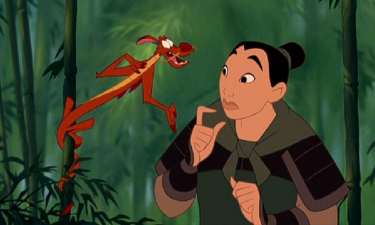
Mulan II shares a similar ratio to its predecessor at 1.78:1 and the native digital transfer reproduces the slightly more simplified look as to be expected from a DTV title. As opposed to the earlier DVD, the contrast seems to have been increased to present a more theatrical appearance than the earlier disc, and that direct-to-video stigma is less obvious. Some budget effects (especially the video-based fireworks) stand out more, but at least things don’t seem as DTV-clinical as usual, which does help the production value. Artistically, the largely Japanese animated characters stay on model throughout – this is easily that Studio’s best work – and there are the odd touches that remind that even a secondary, made-for-the-money Disney product is still a cut above the rest.
Scratch Tracks:
Opening up Mulan’s previous DVDs’ Dolby mixes is an enveloping DTS-HD MA track that allows the sound to spread around and make an impact. Considering that animated films have no on-set audio to work with, the designers here create an authentic soundfield that compliments the visuals nicely. Goldsmith’s score is the main beneficiary of the non-compressed track, with overall strong bass and a decent high-end. In a bit of a disappointment, we lose the Mandarin Chinese mix from an earlier DVD, which was highly entertaining to hear and lent something of an “authenticity” to the movie. For the sequel, the debut of a DTS track is as lively as the film’s narrative will allow: there’s not too much action this time around, but voices and especially the musical score do sound excellently reproduced. Punching the bass up a little revealed a robust, if not exemplary, track; French and Spanish dubs and subs are optional.
Final Cut:
Almost one of the great modern Disney films, some varying degrees of over familiarity just slightly hold Mulan back. Certainly one of the Studio’s better efforts of the late 1990s, this Blu-ray edition makes for a very pleasing presentation. We’re still provided just the right amount of in-depth material on its production, perhaps painting Mulan as a more important film than it possibly is. However, as the first of the three features to come from the Florida unit, it is perhaps deserved of that honor. Mulan II struggles to reach the same depths, but at least it knows its place and doesn’t really have the power to unbalance anything that could potentially tarnish the original.
Better than average DTV animation, a couple of nice moments that could have been expanded to help extend the scope of the picture, and a score that again confirms Joel McNeely should be getting better gigs, Mulan II came quick enough after the first film and is much less of an embarrassment than others of its kind so as to be quite welcome here, especially as it hasn’t meant the dropping of the majority of the original DVD’s special edition extras. As with the concurrent issue of Brother Bear and its own video sequel, there’s nothing new here, but that Disney continues to provide catalog title releases without dropping chunks of supplements into a virtual vault should be supported, and this is another fine set to add to our BD collections.
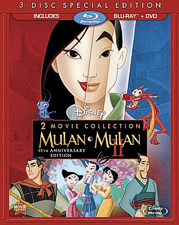 | ||
 |


